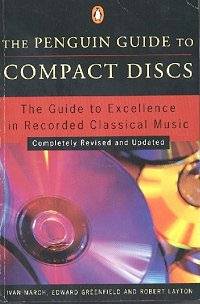
The latest version of this indispensable publication is subtitled “The
Guide to Excellence in Recorded Classical Music”. In the forward the
author’s remark that the current survey gathers together the very finest
CDs issued over the last sixteen years. They have survived in the catalogue
because their excellence is recognised; if deleted it is unusual for them
to remain outside the catalogue for very long. They also consider that the
majority of the very best discs are at premium price and are worth it —
this is a view that perhaps not every record collector will hold.
Under the editorship of Ivan March, this series of books started as the Stereo
Guide in the early days of stereo records. The original team included Edward
Greenfield and Dennis Stevens, then Robert Layton joined; later Dennis Stevens
had to give up. When the early versions were published, the situation regarding
the issue of classical recordings was reasonably stable. Nearly all were
issued by a handful of major record companies (EMI, DGG, Decca, Philips,
CBS, RCA) alongside a relatively small number of independent companies. The
CD era, after a slow beginning, brought a massive expansion of sales as the
majority of collectors changed their LP collections to the CD format, this
coincided with a general increase in interest in classical music and also
increased prosperity. This early success of the new medium was dominated
by the major companies who were also able to sell massive numbers of re-issues
of older tracks which in many cases sounded much better than the original
LP and were comparable in sound quality to new issues. A number of independent
companies, notably Chandos and Hyperion, were very successful in choosing
imaginative repertoire combined with high quality of recordings and they
continue to be successful at full price.
However the economic downturn in the early nineties also led to a catastrophic
downturn in influence of the major companies in the classical field.
Traditionally these companies had relied upon emphasis on artists rather
than repertoire for their sales but this policy was no longer successful
as few collectors were interested in replacing their CDs of artists like
Karajan and Beecham with modern artists — especially at a premium price.
The other great success story was Naxos. This company originally came to
fame when it sold CDs at less than a fiver in stores such as Woolworth. At
first, their recordings used mainly unknown eastern European orchestras with
conductors with unpronounceable names. Increasingly however, Naxos expanded
both their repertoire and range of artists, their recordings also improved.
Now Naxos dominates the shelves of the classical section of most record shops
and increasingly people are unwilling to pay two or three times as much for
CDs which often are seen as being only marginally better.
This new Penguin Guide thus serves as an invaluable review of the work of
the record majors which often still comprise the best of the standard repertoire
and will not readily go out of date. Companies like Hyperion (e.g. with their
excellent romantic piano concerto series) and Chandos (e.g. with their Opera
in English series) have little or no competition in their chosen new repertoire
although Naxos are now extending their recordings more widely than would
have predicted a few years ago. When choosing a recording, the Penguin Guide
is always my first step and over the years the authors have gained a well
deserved reputation for consistency and excellence. It will be very rare
for you to be disappointed with recordings praised by them even though inevitably
personal taste will not always coincide with all the judgements. The one
problem which can arise is a result of the policy of concentrating on excellence
— when a particular available recording is not reviewed, the reader
does not know whether it is not there because of an oversight or because
it was thought to be so poor as not to warrant a review (however this is
seldom a serious problem in practice).
The authors continue to award one of their now famous Rosettes to a limited
number of recordings. A Rosette is a quite arbitrary compliment by a member
of the reviewing team to a performance which seems very special or illuminating.
Many have been awarded to very well known indisputably special performances.
In a few cases however I do have reservations, for example the Rizzi version
of Gounod's Faust is a fine modern recording - but is the conducting as good
as Beecham's? The Guide is especially useful in its treatment of historical
recordings. There has been an increased interest in re-issues of old recordings
including many which go well back into the days of the 78. In addition to
re-issues by the major companies, a number of small specialist enterprises
(of which Dutton Laboraties is especially esteemed) are now producing historical
recordings of a quality which can only be described as magical. This Guide
is particularly helpful in putting these CDs into context alongside modern
recordings rather than keeping them as a special category.
This Penguin Guide has been a massive undertaking, with 1637 pages of closely
written material in a new double column format which allows the review of
even more recordings than before. Not everything is included — this
would be impossible. But the judgements are good, the writing clear and the
information reliable and accurate. This is a ‘must have’ for any
serious collector of classical recordings.
Reviewer
Arthur Baker
In a publication of this size and complexity one might expect some errors.
It is particularly unfortunate that this issue lists the Première
recording of Ruth Gipps 2nd Symphony coupled with Arthur Butterworth's First
symphony, ClassicO CLASSCD 274 and in both occurrences the composer has been
listed as Gibbs. see CD review.
Len Mullenger
